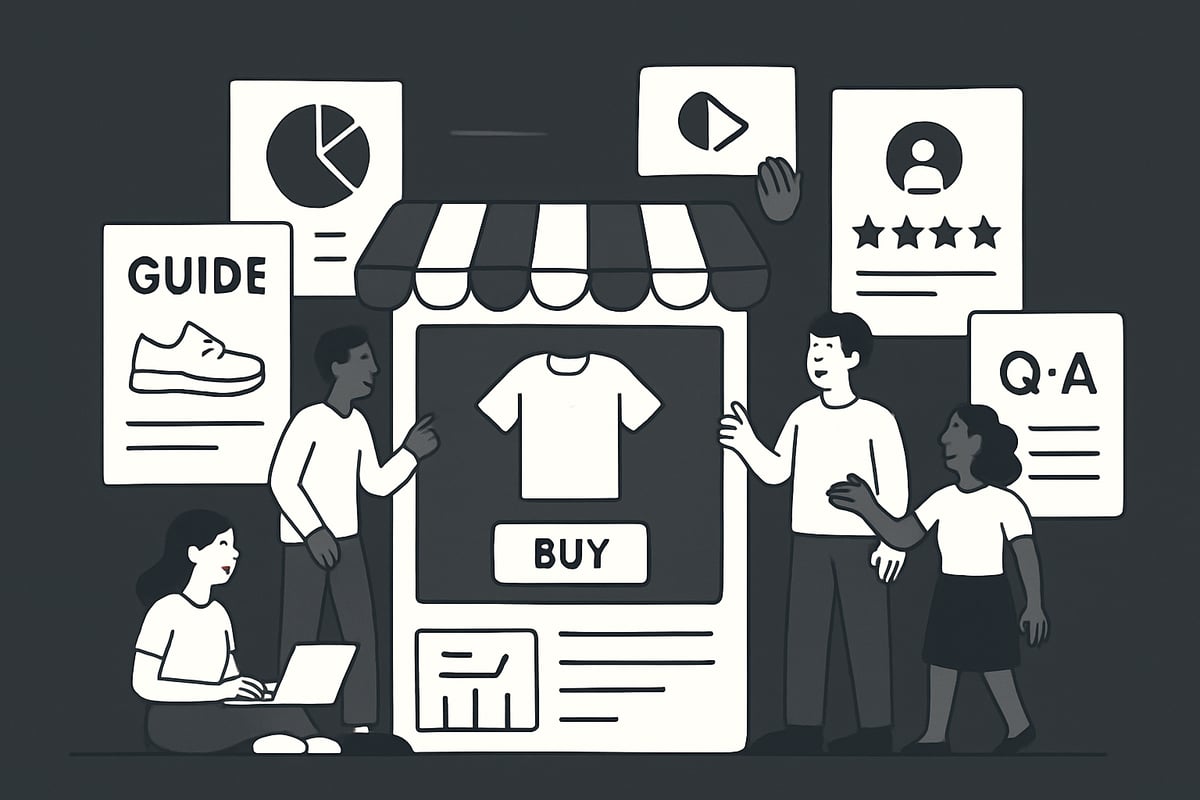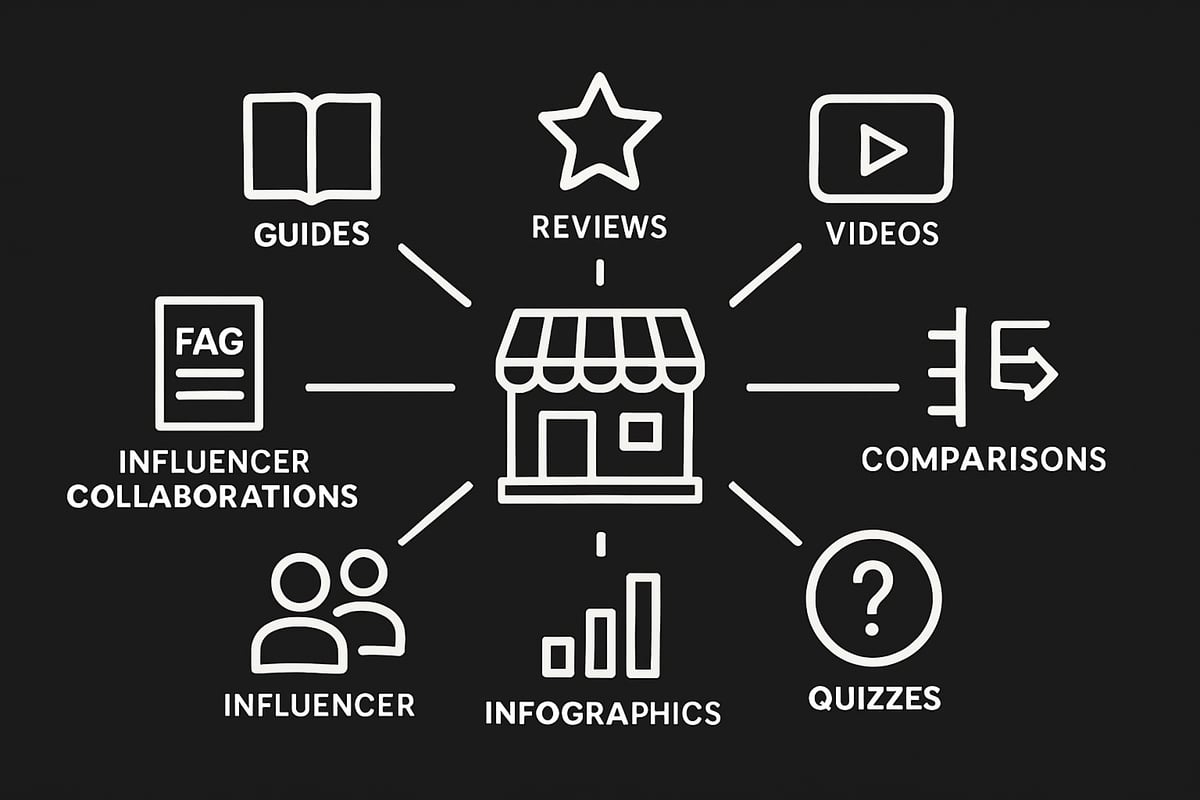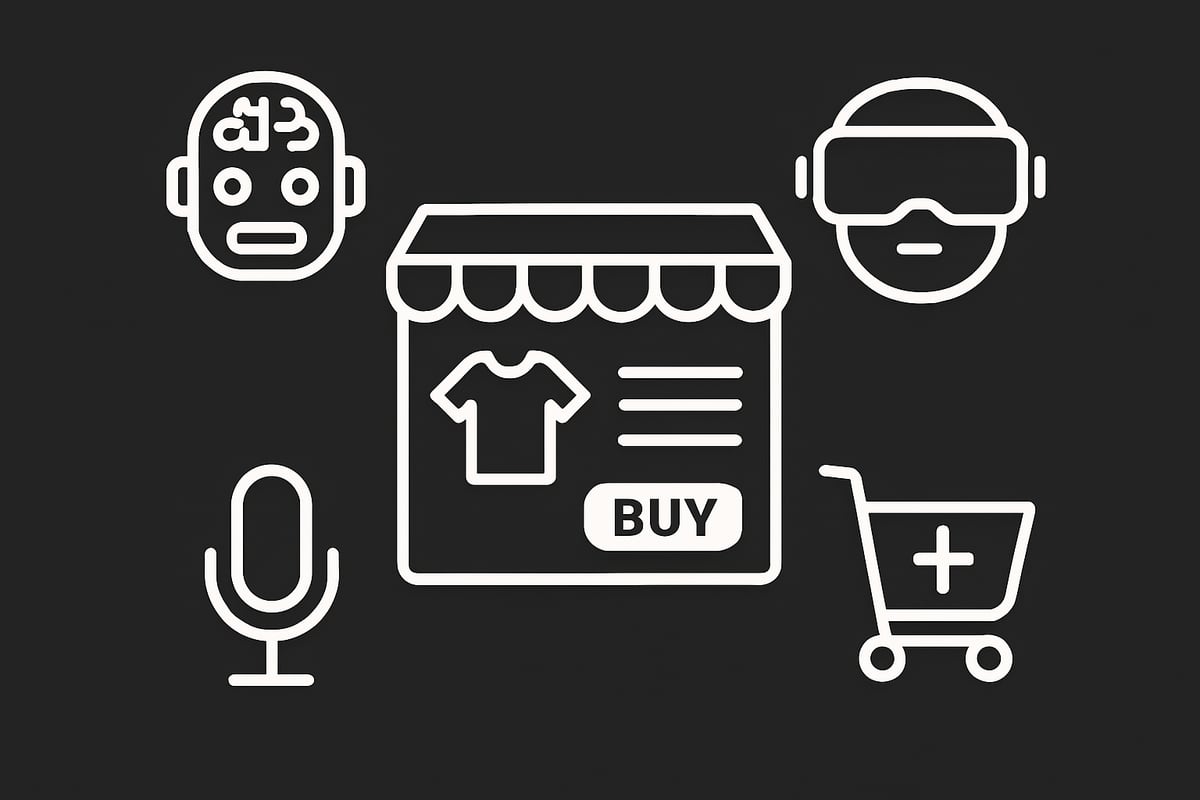Did you know that ecommerce content strategies can boost conversion rates by up to 30%? As competition intensifies in the digital marketplace, standing out in 2025 will require more than just great products. Innovative ecommerce content is now the key to capturing attention, building trust, and guiding customers toward purchase.
This article reveals eight powerful ecommerce content ideas designed to drive sales growth in the coming year. You’ll discover practical strategies, proven examples, and actionable tips that leading brands use to win customers and outpace the competition. Ready to transform your approach? Let’s explore what works—and why you should start implementing these ideas now.
Why Ecommerce Content Matters for Sales in 2025
Ecommerce is evolving at breakneck speed, with customers demanding more than just a seamless checkout. Today, ecommerce content is the bridge between curiosity and conversion. As we enter 2025, brands face a crowded, competitive landscape, where only those with compelling, informative experiences will thrive.

What’s Changing in Ecommerce?
Customer expectations for ecommerce content have never been higher. Shoppers now expect rich visuals, detailed descriptions, and interactive tools before making a purchase. Brands that provide these experiences consistently outperform those that do not. The competitive gap is widening, and content is the deciding factor for customer loyalty.
Data-Driven Results: Why Content Pays Off
Studies show content-rich ecommerce sites experience higher engagement and conversion rates. According to Content Marketing Statistics 2025, video demonstrations can boost purchase intent by 73%, while user-generated reviews can increase conversion rates by up to 18%. These results highlight how ecommerce content directly impacts the bottom line, making it a core growth driver for modern brands.
Content Throughout the Buyer’s Journey
Ecommerce content influences every stage of the buyer’s journey. From discovery, where SEO-optimized guides attract organic traffic, to decision-making, where comparison articles and reviews address last-minute doubts, content guides customers forward. Interactive tools like quizzes and calculators personalize recommendations, increasing the likelihood of purchase.
Personalization and Value in 2025
In 2025, personalization and value-driven ecommerce content are essential for building trust and loyalty. Customers want to feel understood, not just sold to. Brands that deliver tailored experiences—such as expert advice, relatable stories, and relevant FAQs—create lasting relationships. This approach turns one-time buyers into repeat customers and brand advocates.
The Need for Strategy and Optimization
Simply producing more ecommerce content is not enough. Brands must adopt a strategic approach, aligning content with business goals and customer needs. As algorithms and consumer behaviors shift, ongoing optimization is critical. Regularly updating guides, refreshing visuals, and analyzing performance metrics ensure content remains effective and relevant in a dynamic market.
8 Powerful Ecommerce Content Ideas to Boost Sales in 2025
Innovative ecommerce content is the engine behind successful online stores in 2025. As customer expectations rise and competition grows fiercer, brands must leverage a diverse range of content strategies to drive engagement, trust, and ultimately, conversions. Here are eight proven ecommerce content ideas—each designed to boost sales, improve user experience, and future-proof your brand.

1. Product Education Guides
Product education guides are a cornerstone of effective ecommerce content. These resources simplify complex buying decisions by addressing customer pain points and answering frequent questions. For example, REI’s “How to Choose Hiking Boots” offers step-by-step advice, visuals, and actionable tips, making it easier for shoppers to select the right product.
Well-designed guides target long-tail, high-intent search queries—capturing users who are ready to buy. Incorporate internal links to product pages for seamless navigation and a clear conversion path. Use structured sections, bullet points, and images to break down details, enhancing readability and engagement.
Consider the following structure for your guides:
| Section | Purpose |
|---|---|
| Introduction | Context and key benefits |
| Product Features | Detailed breakdown |
| How to Choose | Step-by-step selection guide |
| FAQs | Addressing common concerns |
| Related Products | Cross-selling opportunities |
Buyers’ guides can increase time on site and reduce bounce rates by keeping users engaged. Update guides annually to reflect new products and trends, ensuring your ecommerce content remains accurate and valuable. For a deeper dive into how content strategies drive real conversion improvements, see Understanding Ecommerce Conversion.
2. Customer Reviews and User-Generated Content
Nothing builds trust in ecommerce content like authentic customer reviews and user-generated content. Shoppers crave real experiences, and studies show that user reviews can lift conversion rates by up to 18%.
Encourage customers to share their feedback through post-purchase emails, incentives, or loyalty programs. Display reviews prominently with star ratings, photo uploads, and video testimonials to make an immediate impact. Fresh, keyword-rich review content also boosts your SEO performance, keeping product pages dynamic and relevant.
To maximize authenticity, moderate reviews to filter out inappropriate content while preserving genuine voices. Integrate customer stories, Q&A sections, and even before-and-after photos to add richness to your ecommerce content. Repurpose standout reviews into email and social campaigns to extend their reach and reinforce your credibility.
3. Comparison and “Best Of” Articles
Comparison and “Best Of” articles help customers navigate crowded markets and make confident purchase decisions. These pieces target high-intent, bottom-of-funnel keywords—ideal for shoppers ready to buy but needing clarity between options.
Structure comparisons with side-by-side tables, clear pros and cons, pricing breakdowns, and unique selling points. For example, tech sites often create “Best Laptops for Students” lists, featuring comparison charts and honest evaluations.
Here's a sample comparison table:
| Product | Price | Key Feature | Unique Benefit |
|---|---|---|---|
| Product A | $199 | Lightweight | Longest battery life |
| Product B | $179 | Touchscreen | Most affordable |
| Product C | $249 | 2-in-1 Design | Best for multitasking |
Well-executed comparison content increases time on page and reduces decision fatigue. Always use honest, transparent evaluations to build trust. Internal links to relevant product categories and pages help guide readers toward purchase, making these articles a foundational pillar of ecommerce content.
4. Video Demonstrations & Tutorials
Video is a powerful driver of ecommerce content performance. According to Demandsage, 73% of people prefer video over text when learning about products. Videos can showcase features, demonstrate real-life usage, or offer unboxing experiences—giving shoppers a clear sense of what to expect.
Keep videos concise, focusing on benefits and key use cases. Always include calls-to-action and optimize titles and descriptions for SEO. Brands like electronics retailers often use setup guides or quick tips to reduce product returns and boost buyer confidence.
Best practices for ecommerce video content include:
- Use captions for accessibility.
- Integrate videos on product pages, social media, and email.
- Track metrics like view duration, click-through rates, and conversion lift.
By delivering engaging, informative videos, your ecommerce content can turn browsers into buyers and reduce hesitation at the point of purchase.
5. Interactive Content (Quizzes, Calculators, Virtual Try-Ons)
Interactive content is redefining ecommerce content by making shopping more engaging and personalized. Tools like product recommendation quizzes, size calculators, and AR-powered virtual try-ons help customers find their perfect fit, boosting satisfaction and conversion rates.
Competitor data shows that interactive tools increase dwell time and reduce bounce rates. They also collect valuable customer data for future marketing efforts. Design quizzes and calculators to be intuitive and genuinely helpful, with clear outcomes and recommendations.
Consider these popular interactive content types:
- Product finders (“Which laptop is right for you?”)
- Size and fit calculators
- Augmented reality try-on experiences
Integrate these features with product pages and retargeting campaigns. Always optimize for mobile devices, as more shoppers browse and buy on smartphones. Shareable interactive content also increases reach on social media, expanding your brand’s ecommerce content footprint.
6. Data-Driven Content & Infographics
Original research and infographics help brands stand out in a crowded ecommerce content landscape. By publishing unique studies or visual guides—such as “Most Popular Dog Breeds by State”—you demonstrate expertise and authority.
Infographics are highly shareable, driving backlinks and organic traffic. Use customer surveys, sales data, or industry reports to source insights. Focus on clear, compelling design and storytelling; avoid clutter and prioritize key takeaways.
Tips for impactful data-driven ecommerce content:
- Repurpose infographics for blogs, social, and email.
- Use tables and charts for clarity.
- Update visuals regularly to keep information current.
Statistics show that visual content generates higher engagement rates than text alone, making this approach essential for modern ecommerce content strategies.
7. Expert Roundups and Influencer Collaborations
Expert roundups and influencer collaborations add authority and credibility to ecommerce content. By featuring industry leaders, influencers, or satisfied customers, you tap into new audiences and foster trust.
Brands like Gaia have found success with expert lifestyle tips and influencer endorsements. Structure roundups using Q&A formats, top tips, or product recommendations—making content easy to scan and share.
Benefits include:
- Increased social shares and referral traffic
- Valuable backlinks from contributors’ networks
- Enhanced brand reputation
Leverage influencer content across your blog, social media, and email campaigns. Always prioritize transparency and authenticity; disclose partnerships and avoid over-promotional messaging. Track engagement and referral metrics to measure ROI and refine your ecommerce content approach.
8. FAQ Hubs and Knowledge Bases
Comprehensive FAQ hubs and knowledge bases are crucial components of ecommerce content. They remove barriers to purchase by addressing product details, shipping, returns, sizing, and troubleshooting in one accessible location.
Competitor analysis highlights the SEO value of question-based content. Use schema markup to enhance visibility in search results and drive qualified traffic. Structure your FAQ sections with clear categories and concise answers, drawing on real customer inquiries and feedback for ongoing updates.
Benefits of robust FAQ ecommerce content include:
- Reduced customer service workload
- Improved customer satisfaction and trust
- Seamless linking to guides, product pages, and support resources
Brands with high-performing knowledge bases see lower cart abandonment and higher post-purchase confidence. Keep your FAQ content fresh and relevant to maintain its effectiveness.
How to Develop a Winning Ecommerce Content Strategy for 2025
Crafting a winning ecommerce content strategy in 2025 requires clarity, agility, and a relentless focus on your audience. As competition intensifies, a strategic approach ensures every piece of ecommerce content delivers measurable results.

1. Set Clear, Measurable Goals
Begin by defining what you want your ecommerce content to achieve. Are you aiming for higher conversion rates, increased traffic, or stronger customer loyalty? Align these goals with broader business objectives. For example, if your target is a 20% sales increase, set content KPIs like improved time on site or lower bounce rates. This alignment keeps your strategy focused and accountable.
2. Know Your Audience Inside-Out
Effective ecommerce content speaks directly to your ideal customers. Conduct audience research and develop detailed personas. What are their pain points? Which platforms do they use? How do they make purchase decisions? Tailor your topics, formats, and tone to these insights—personalization is key to building trust and driving engagement.
3. Audit and Prioritize Your Content
Regular audits reveal what’s working and what isn’t. Review existing blog posts, guides, and product pages. Identify gaps, outdated information, and opportunities for improvement. Competitor benchmarking can also uncover new content angles. For a deeper dive into planning, see this Growth Marketing Strategy for Ecommerce guide, which outlines proven tactics for content-driven growth.
4. Plan, Execute, and Optimize
Build an agile content calendar that adapts to trends and seasonality. Prioritize high-impact initiatives first, such as launching a new buying guide or revamping your FAQ hub. Collaborate across marketing, product, and customer service teams to ensure your ecommerce content is accurate and comprehensive.
Leverage analytics tools to measure performance—track metrics like page views, conversion rates, and engagement. Use insights to run A/B tests, gather feedback, and continuously refine your approach. For current benchmarks and trends, consult Ecommerce Marketing Statistics 2025 to inform your content decisions.
5. Continuous Improvement for Lasting Results
The ecommerce content landscape evolves quickly. Stay ahead by regularly updating your assets, learning from data, and experimenting with new formats. This proactive mindset will keep your strategy effective and your brand competitive in 2025.
Future Trends: What’s Next for Ecommerce Content in 2025?
The future of ecommerce content is rapidly evolving, driven by both technology and changing consumer expectations. In 2025, brands that embrace innovation will set themselves apart in a crowded digital marketplace.
One of the most influential trends is AI-powered personalization. Machine learning is enabling brands to tailor ecommerce content to each visitor’s preferences, behavior, and purchase history. As highlighted in AI and Ecommerce Content Trends, AI is not only optimizing recommendations but also automating content creation and testing, increasing efficiency and relevance.
Another major shift is the integration of AR and VR, allowing customers to virtually try products before buying. These immersive technologies are making ecommerce content more interactive and experiential. Voice search optimization is also on the rise, requiring brands to adapt their content for conversational queries and smart assistants.
Shoppable content is becoming essential, seamlessly blending product discovery with instant purchasing across channels. Industry forecasts show that brands investing in omnichannel strategies and interactive experiences will see higher engagement and conversion rates. For additional insights, Content Marketing Statistics for 2025 breaks down emerging trends in personalization, interactivity, and content-driven sales.
To stay ahead, brands should:
- Monitor competitors and consumer behavior for early trend adoption.
- Invest in scalable, data-driven content creation platforms.
- Prioritize authenticity, transparency, and value-driven storytelling.
Ultimately, the brands that future-proof their ecommerce content strategy will be best positioned for sustained growth in 2025 and beyond.
